#Adrasto
Explore tagged Tumblr posts
Text

Lee la primera parte aquí.
Lee la segunda parte aquí.
La gran tragedia de los siete contra Tebas
Tercera y última parte
La muerte de Polineces, la desaparición de Anfiarao y la tragedia de Antígona
Ya sólo quedaban Polinices, Anfiarao y Adrasto. Para evitar más muertes, Polinices retó a su hermano a luchar, y quien ganara se quedaría con el trono de Tebas. Hiriéndose ambos de muerte, Creonte, tío de ambos y padre del occiso Meneceo, tomó el trono y el liderazgo del ejército y venció a Anfiarao y Adrasto. El primero huyó a toda velocidad. Cuando estuvo a punto de ser asesinado por un guerrero tebano, Zeus hizo que la tierra se lo tragara tanto a él como a su auriga Batón. Desde entonces, Anfiarao reina vivo entre los muertos.
Creonte prohibió cualquier ritual funerario para los guerreros argivos. Así que Antígona, hermana de Polinices y Eteocles, se apresuró a hacer una pira en secreto para el cadáver del primero, ya que el otro recibió los honores propios de su cargo como rey tebano. En cuanto Creonte se enteró, llamó a su hijo Hemón, prometido de la mujer, y le ordenó enterrarla viva junto con el cadáver de su hermano. El muchacho estaba muy enamorado de ella, así que mintió a su padre y escondió a Antígona en la montaña. Allí, viviendo entre pastores, dio a luz a un hijo.
Adrasto escapó de vuelta a Argos, pero pronto volvió a Tebas cuando supo que el rey Creonte prohibió los rituales para los argivos. Desesperado, partió a la ciudad de Atenas, donde reinaba Teseo. Le suplicó a este que intercediera ante Creonte para darle entierro a sus guerreros. Así, Teseo atacó Tebas, apresó al rey y entregó los cuerpos a sus respectivos parientes. Los dolientes hicieron una gran pira para quemarlos a todos, pero Evadne, esposa de Capaneo, se negó a separarse de su esposo, a tal grado que se lanzó al fuego aferrada al cadáver.
Pasaron varios años desde la tragedia de los siete contra Tebas. En unos juegos fúnebres, Creonte reconoció a su nieto, hijo de Antígona y Hemón, por una marca que tenían todos los descendientes de Cadmo, tatarabuelo del padre de Antígona, Edipo. Creonte lo condenó a muerte, así que Hemón mató a Antígona y luego se suicidó.
www.mitosenespanol.tumblr.com
Créditos de la imagen aquí.
Lee mitos coreanos aquí.
Lee mitos japoneses aquí.
Conoce los símbolos del Tarot aquí.
#mitología griega#hellas#grecia#mitos griegos#mitos y leyendas#hélade#greece#greek mythology#dioses griegos#grecia antigua#Tideo#Adrasto#Teseo#Creonte#Polinices#Antígona#Los siete contra Tebas#Esquilo
4 notes
·
View notes
Text

Adrastos Dakota
17 notes
·
View notes
Text
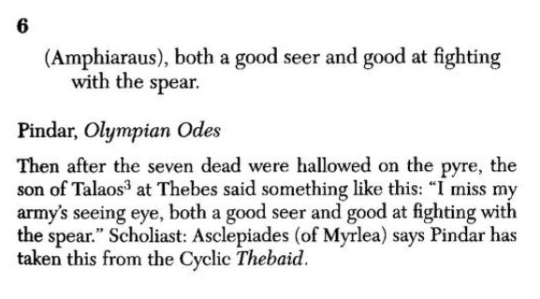
Epic fragments thebaid 6
#adrastos#adrastus#amphiaraus#amphiaraos#greek mythology#tagamemnon#ancient greece#the thebaid#he killed his father and he say smth like this
8 notes
·
View notes
Text
The Best Friend
Ismini has had two close friendships in her lifetime so far. The first is with her cousin, Kyllian, who was raised by her mother and stepfather. Kyllian is a year older than her and is her mother's nephew. They were each other's best friend up until Ismini was 17 - where one decision tore them apart for the next several years.
A year or so after, though, Ismini met Rasha, the carpenter on Captain Laertes Adrastos's ship. She's about four or so years older than Ismini, but has experience in ship building and also disguises, which is how Rasha first got onto Captain Adrastos's ship; disguised as a man. Luckily for her, Adrastos found the trick to be impressive and allowed her to remain on board. Rasha eventually joins Ismini on her escapades across the Mediterranean.
2 notes
·
View notes
Text
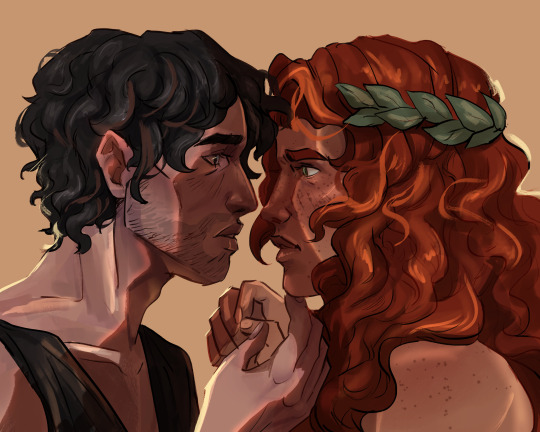
"I'm in love with the idea of dying With you in my arms but not like this We can't really help who we are."
3 notes
·
View notes
Text
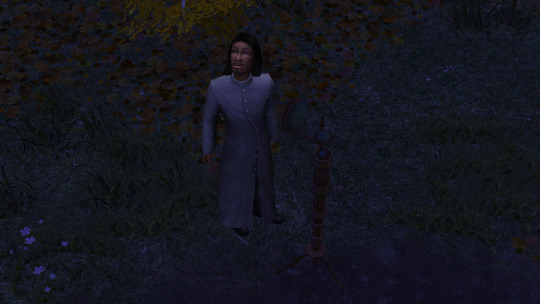
Adrastos has never really spent a lot of time just looking up at the vastness of space, preferring more earthly pursuits, but there's something about all of those stars that he finds compelling lately.
10 notes
·
View notes
Text

VARATHRON "Genesis of Apocryphal Desire" CD Compilation 1997 ('Ygnai Fthig Nga Sothoth - Ym'Bd'Nig Ch'Eye Do Xna Ngrktl 'Ftythech Gia Nghaa - Jug Mglo Mnyg Nafth. Within his castle in R'lyeh - The dead Cthulhu awaits, while dreaming...')
"The golden cities once - Desperately loved to rose From fathomless grey mass - Blue lakes and abyssic mountains
Fear, for something that will gonna be Fear, for something that will never (gonna happen) Mercy and mighty echoes lamentation and tearing From a voiceless face (without ending)
The shining towers of Hy-Brasyl - Earthy and heavenly paradise Where men walked with gods - And with beasts of the forest
Time when springtime and harvest Were as one ; flowers and fruits - Hung heavily on every bough Like a dream beyond the dimensions The wind was blowing like a lover's touch Caressing the highest towers The mist like a sinful soul - Was searching its salvation
The time when hands moved Only in grace and giving, the eyes smiled The lips spoke with love without shame
Spirits travelling on a labyrinth Without fear but passion - Bravery without bloodshed
Pictures from the past - Unspoken dreams of today Mysterious visions for the future It's time you will learn from yourself"
#Varathron#Black Metal#Occult Art#Stefan Necroabyssious#Jim Mutilator#Themis Tolis#Spiros 'Captain Death'#Giannis Vekiris#Stavros Mitropoulos#Pyrphoros#Adrastos#Cursed Productions#William Hogarth#Hellenic Black Cult
9 notes
·
View notes
Text

Lee la primera parte aquí.
La gran tragedia de los siete contra Tebas
Segunda parte
La instauración de los Juegos Nemeos
Antes de su arribo a Tebas, los guerreros hicieron una parada en la ciudad de Nemea, gobernada por el rey Licurgo, a quien solicitaron beber de sus manantiales. La niñera de su hijo, Hipsípile, fue la encargada de llevarlos a la fuente más cercana, dejando sólo al pequeño Ofeltes. Mientras el ejército argivo bebía, una serpiente mordió al niño, quien murió inmediatamente. Anfiarao advirtió que aquello era un mal augurio, así que los guerreros se apresuraron a celebrar unos juegos fúnebres en honor al niño, que desde ese momento empezó a ser llamada Arquemoro “el iniciador de la fatalidad”, esperando así mejorar su fortuna. Desde aquel terrible incidente se instauraron los juegos nemeos, en el que los participantes deben llevar túnicas negras.
El arribo a Tebas y la muerte de los primeros guerreros
Una vez que se acercaron a las murallas de Tebas, Adrasto envió a Tideo como heraldo para que exigiera el trono para Polinices. Ante la negativa de los tebanos, el guerrero retó a los líderes del ejército a luchar cuerpo a cuerpo. Vencidos todos, los demás soldados retrocedieron animando así a los siete a escalar las siete puertas de las murallas. En un principio, Eteocles, hermano de Polinices, se sintió nervioso ante el rápido avance de los siete; pero pronto recordó que el profeta Tiresias le había dicho que Tebas resultaría victoriosa si un hombre de sangre real se ofrecía como sacrificio a Ares. Así, Meneceo se lanzó desde la muralla y murió, haciendo que Tebas lograra el favor del dios de la guerra.
Mientras los siete escalaron la muralla, Zeus lanzó uno de sus rayos contra Capaneo, precipitándolo contra el suelo y muriendo al instante. Mientras tanto, un soldado tebano de nombre Melanipo asaltó a Tideo y le perforó el estómago, haciéndolo también caer. Mientras yacía moribundo, Atenea se conmovió y se apresuró a llevarle un elixir para curarlo. Anfiarao, que odiaba a Tideo por haber promovido tal empresa contra Tebas, le puso una treta al guerrero, que terminó por sellar su destino: cortó la cabeza de Melanipo y se la arrojó mientras gritaba “Éa, véngate y cómete los sesos”. Así lo hizo Tideo ante la mirada atónita de Atenea que, asqueada, arrojó el elixir al suelo y huyó encolerizada. Hipomedonte y Partenopeo murieron a manos de los tebanos.
Continuará...
Primera y tercera parte.
Créditos de la imagen aquí.
Lee mitos coreanos aquí.
Lee mitos japoneses aquí.
Conoce sobre los símbolos del Tarot aquí.
#mitología griega#hellas#grecia#mitos griegos#mitos y leyendas#greece#hélade#greek mythology#dioses griegos#grecia antigua#Adrasto#Tideo#Polineces#Juegos Nemeos#Los siete contra Tebas#Esquilo
3 notes
·
View notes
Text
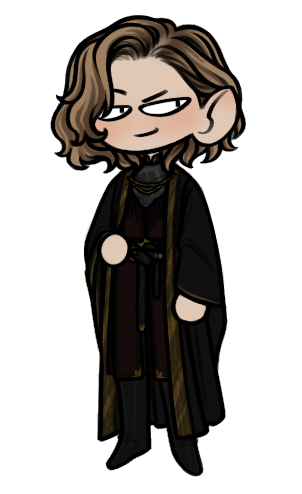
*shaking the bars of my enclosure
I LOVE HIM A LOT OK HE'S SO CUTE
0 notes
Note
since u wanted to know..*cracks knuckles*
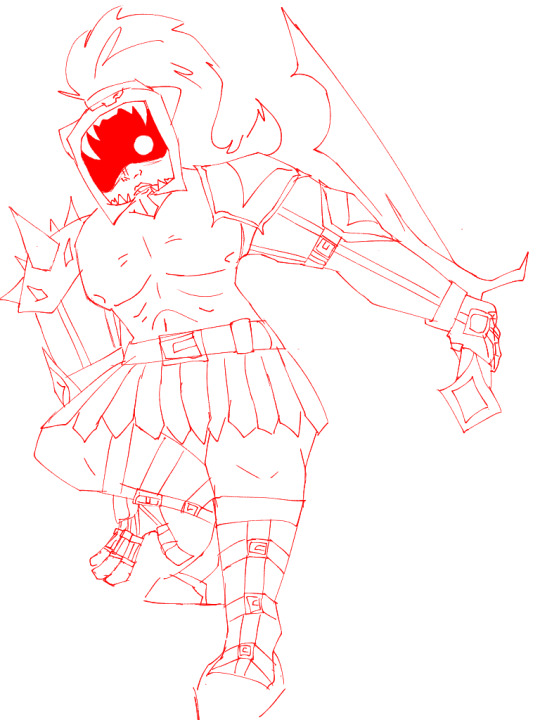
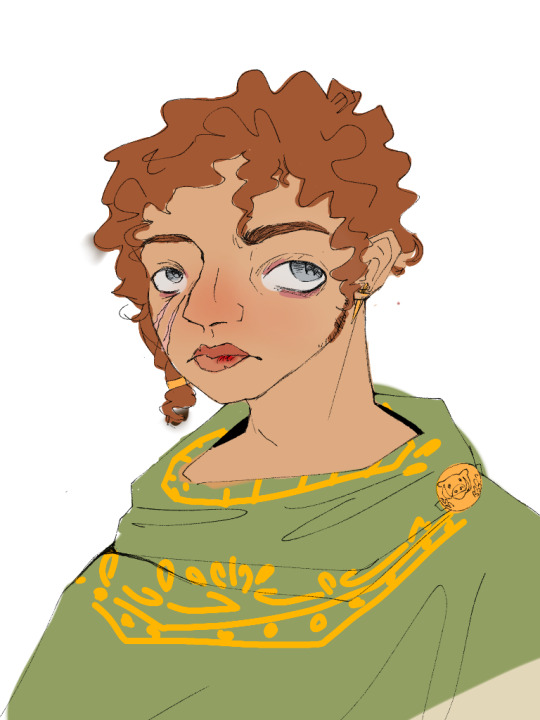

THIS fine fella is adrastos of sparta! a (not out,of course, This is ancient Greece) trans man and chosen warrior of ares, he's in his late twenties. has a joint diesesea, hence the braces on his arms,legs, and not pictured here,a back brace.(it's Ehlers-Danlos. undiagnosed because,again,ancient Greece. and yes he SHOULD be in a wheelchair,but ancient Greece)
he came to the palace on the orders of ares who wanted to make sure athen keeps her word and ody gets a bloodbath going, this makes him a very late arrival. combined with being extremely antisocial and Having to hide his gender (pretty hard in a culture where nudity is so normalized) this means he is very much picked on by the other suitors.not that he doesn't deserve it,he's a rather cold and violent man,who doesn't care for anything that's happening in the palace and just wants to go back to the battlefield. (Telemachus asked him to train together once and he yelled at the kid for crying when he broke his arm)
he's also very insecure about his masculinity and will lash lash out in the weirdest of situations because of it.
some fun facts include:
- he doesn't know how to dance, which ares is very upset about as the god of dancing (seriously,he is,you can look it up if u dont Believe me.)
-he doesn't drink,like every, which is super unusual for a greek.he wants to always be fully battle ready
-may not look like it but loves gossip,will just hang in the back of a room and listen in on people (him and eurymachus would get along so well if he gave him a chance)
-chronic lip biter
-gives argos treats when nobody's looking
and this has been my deranged yap,thank you.(you don't have to respond if it's a lot,i understand lmao)
One thing about me is I hate walls of text cause I'm a slow reader but OH THAT WAS WORTH IT
I love him he is so interesting and fully fleshed out. I love an oc that blends well with the canon. He has interesting flaws and qualities I really like him (do you have any ships involving him?)
63 notes
·
View notes
Text
Also, you know.
Aside some acknowledgement of bias because we've all got them; if we want to talk about what people "actually did" in the Iliad (that is, the ~one plus month in the ninth year of the war)...
Achilles: -Biggest own-side killer this side of... well, idk. This man doesn't give a rat's ass about the perfectly innocent footsoldiers on his own side. It's RIGHT THERE IN THE FIRST LINES OF THE PROEM. He asks his divine mother to pull strings for him with Zeus to make Agamemnon and all the Achaeans REGRET. Which means a lot of dead Achaeans. -has a war bride/sex slave/geras. -sleeps with at least one other slave while deprived of Briseis. -refuses to go back when Agamemnon actually does attempt to make amends (no matter how potentially condescending that attempt is). -kills a supplicant on the battlefield. -commits human sacrifice x12. -desecrates/attempts to desecrate Hektor's corpse for 12 days. -threatens to murder an unarmed old man for ~grieving too much~ even AFTER the highest god has already told him to shut up, take the ransom, and give Hektor's body back.
Agamemnon: -verbally abuses and threatens to murder an unarmed priest parlaying explicitly under the banner of his god. -takes someone else's hard-earned geras. -has a war-bride/sex slave/geras. -tests the army for... unearthly reasons and is at least indirectly responsible when Odysseus then goes around and beats up the common soldiers (and sweet-talks the commanders/elites) to make them calm down and shut up. -kills three supplicants (though Adrastos only supplicated Menelaos directly so I suppose it only half counts).
Little Ajax: (-presumably has a war bride/sex slave/geras, but unconfirmed.) -mutilates a Trojan's corpse and tosses his head like it's a ball. -... I think that's it?
Odysseus: -has a war bride/sex slave/geras -beats up a bunch of regular foot-soldiers (and Thersites). -misleads Dolon during his interrogation. -runs away during battle from confrontation at least once (the one I best remember is when Diomedes urges him to help protect Nestor, I believe).
Diomedes: (-presumably has a war bride/sex slave/geras, but unconfirmed.) -commits hubris by attacking Apollo three-four times (only stopping that fourth time, and not by his own acknowledgement that he is wrong but only because Apollo TELLS HIM OFF). (-attacks Aphrodite and Ares, but since he does so under Athena's auspices, idk how much we can count it against him). -verbally abuses Aphrodite. -murders a number of sleeping people.
Paris: -throws out a general/nondescript challenge and then promptly retreats when Menelaos attempts to take him up on it. -does not go back out onto the battlefield after Aphrodite yoinked him off it without being told by Hektor (a space of time that involves a couple hours, half a day, at most). -refuses to hand Helen back in the nightly council.
#greek myth thoughts#this list would look a little different if we were taking the whole war into account#but since we're not...
58 notes
·
View notes
Text
🫒🌿 Eleos, Goddess of Mercy and Compassion 🫒🌿
❤️ A Hymn by Willow Greenleaf ❤️

· · ─────── ·𖥸· ─────── · ·
Great Goddess Eleos, Goddess of Mercy and Compassion; born from your father Erebos, God of darkness, and your mother Nyx, most ancient and heeded Goddess of the Night. Oh Eleos, Goddess of compassion, I sing of you Misericordia, your divine grace shining over all, no matter who they may be. It was you, Goddess Eleos, who answered Adrastos’s prayers and swayed the Athenians to fight in defense of the dead and it was also you oh Great Eleos, who heard the cries of Herakles’s sons and secured them refuge with the Athenians, Great Goddess. Hear us Clementia, hear our cries and grant us mercy, let us sway your heart and win your favor so that we may also be granted mercy in our darkest moments. Oh, great Eleos, mother of mercy, granter of compassion, advocate to all, we praise you and we will forever uplift your Holy Name.
· · ─────── ·𖥸· ─────── · ·
Works Cited:
Atsma, Aaron J. “EREBUS (Erebos) - Greek Primordial God of Darkness.” Theoi.com, 2017, www.theoi.com/Protogenos/Erebos.html.
“ELEOS - Greek Goddess or Spirit of Mercy & Compassion (Roman Misericordia).” Www.theoi.com, www.theoi.com/Daimon/Eleos.html.
Theoi. “NYX - Greek Primordial Goddess of the Night (Roman Nox).” Theoi.com, 2017, www.theoi.com/Protogenos/Nyx.html.
Wikipedia Contributors. “Eleos.” Wikipedia, Wikimedia Foundation, 7 Mar. 2024, en.wikipedia.org/wiki/Eleos.
#hellenic#hellenic community#hellenic deities#hellenic polytheism#paganism#god pan#hellenic devotion#gaia#goddess selene#helpol#eleos#mercy#compassion
20 notes
·
View notes
Link
I have contempt for the MAGA reporter who attacked President Zelensky for not wearing a coat and tie in the oval office for not doing likewise with the Salvadoran dictator. I guess it’s okay because Bukele wore a black shirt…
I have contempt for a press corps that fails to point out that Team MAGA is using the same playbook in the illegal migrant deportation cases that it used in its election denial cases. They claim to have evidence but fail to produce it because they’re lying. In a word: Contemptible.
I have contempt for a wannabe dictator who attacks judges with lies. Judge James Boasberg is an old friend of Brett Kavanaugh as well as a member of the Federalist Society. If he’s a far left radical, I’m an Atlanta Falcons fan.
I have contempt for the people who caused this nightmare: those who voted for the Trump-Vance ticket without paying attention to the campaign, which exposed the Insult Comedian as a cognitively challenged lunatic. Thanks, you stupid motherfuckers.
29 notes
·
View notes
Text
Nicolai Abraham Abildgaard, 1743/1809
Danish architect, painter, designer and decorator,

1772/77 Sitting male nude

1774, Male Figure. After Michelangelo's "Last Judgement" in the Sistine Chapel.

1775, The Wounded Philoctetes
Abildgaard completed his artistic training in Rome, Italy, 1772/77, before returning to Denmark, he stayed a few months in Paris,

1775/80 Male nude

1776, Adrastos slays himself on Atys' tomb

1777, Ymir Suckling the Cow Audhumla
Very active during the period 1777/94, he received lucrative commissions from the Danish monarchy which appointed him historical painter to the king around 1780. He then played an important role in the development of the neoclassical movement in Denmark.

1778, Hamlet and his Mother


1790, Ismene and Antogone Plead with Theseus
From 1778, he taught at the Royal Danish Academy of Fine Arts in Copenhagen, where he was elected president from 1789 to 1791. His students included the young Christoffer Wilhelm Eckersberg.

1790, Mercury by the Seashore

1800, Nightmare

1809, Apollo charging the Parcae to visit Ceres, who has fled from the Earth

Amor and Psyche embracing each other

Nicolai Abraham Abildgaard, par Jens Juel, (1772)
12 notes
·
View notes
